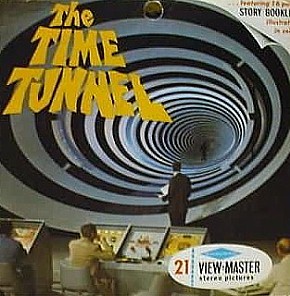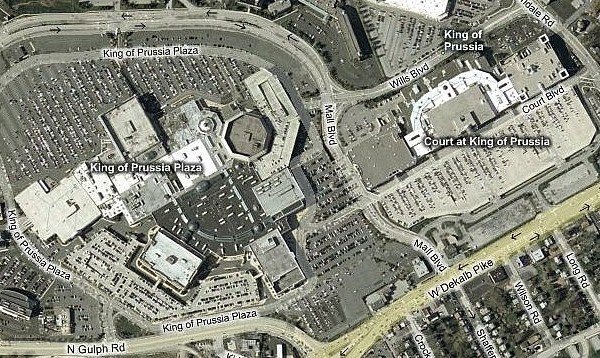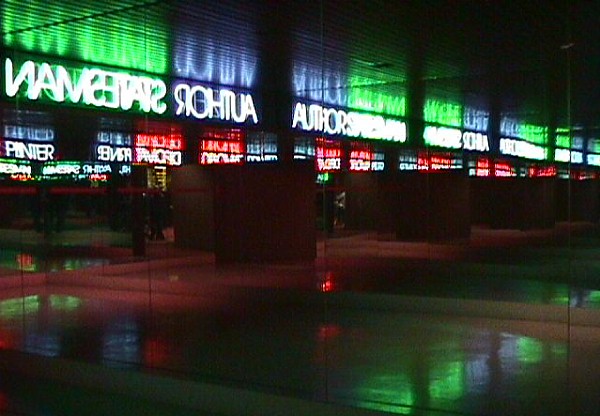1999.03.10 08:48
Re: epic architectural past
I think the "human story," like the movement of the present, is essentially linear. The first humans were extreme, and the best examples of extreme architecture are the Great Pyramids and Stonehenge. Circa 550BC, humanity began to operate with a highly fertile imagination, and this "age of highest fertility" lasted till circa 770AD, at which time humanity's imagination became [additionally] pregnant. At the first trimester of pregnancy, circa 1500, humanity began to assimilate itself and its place in the universe. By 1700, the metabolic imagination began to work in conjunction with the assimilating imagination.
We are today still primarily a humanity operating in both an assimilating and metabolic fashion, and thus our architecture too is primarily both assimilating ("international") and metabolic (creative/destructive).
Of course, the "human story" continues, and to discern how it will continue, you just have to analyze the sequential slices of the human body starting at the lowest tips of the rib cage and moving upwards.
1999.03.10
Jencks/labeling
In his synopsis of Jenck's recent lecture, Stephen Marshall included the phrases:
"life cycles of cities," "cells must die periodically so that other cells--and the organism as a whole -- might live," "cities undergo phase changes."
The word that best describes these notions is metabolic -- metabolism is a duality whereby anabolism is creative metabolism and catabolism is destructive metabolism. The "design of" many cities today exhibit metabolic "operations" when both creative and destructive manifestations occur. Metabolism is perhaps the primordial duality, and, like all dualities, is difficult to resolve precisely because of its inherent opposing forces.
The metabolic "operating system" is very prevalent today, and has been growing in prevalence over the last few centuries. For example, it is easy to recognize Berlin as the foremost metabolic city of the 20th century. Before our time, Piranesi, in his Ichnographia Campus Martius, offers a poignant example of "life and death" in the city, and before Piranesi, perhaps Michelangelo's architecture (and some aspects of Mannerism in general) offers an example of metabolic design, albeit slightly a head of its time.
| |
1999.03.10
classical/modern
Hugh Pearman in two recent posts wrote:
"Architectural operating systems (as opposed to surface styling) are predominantly Gothic or Classical."
"What I called the 'architectural operating system' as a deliberate computer analogy--might clarify rather than confuse, for me if nobody else."
I suggest a wholly other batch of "architectural operating systems" that derive from the morphology and physiology of our own bodies, the machines that we are instead of the machines that computers are.
Some architectures are extreme.
Some architectures are fertile.
Some architectures are pregnant.
Some architectures are assimilating.
Some architectures are metabolic.
Some architectures are osmotic.
Some architectures are electro-magnetic.
Some architectures are total frequency.
Figuring out what buildings/architects fit in which category(s) may well be the ultimate architectural parlor game. (Hint: Classical is high fertility and Gothic is early pregnancy.)
Hugh also made reference to the notion of architects having "to have his or her 'personal myth' to believe in and guide them." For what its worth, I have "discovered" my own myth, and its called The Timepiece of Humanity or the theory of chronosomatics.
2001.03.10 10:48
Re: George Washington's Presidential...
I recently read four chapters on the 'preservation' of 'historic' Philadelphia (temporary capital of the United States 1790-1800) in L. Mumford's Highway and the City. I actually found out about these texts from John Young vis-à-vis 'talk' about reenactment and "re" words. It seems that Mumford was lecturing at the University of Pennsylvania in the late 1940s and that was when the historic districts around Independence Hall (actually the Pennsylvania State House) were being newly planned and 'preserved'. I was surprised at how unprecedented American historic preservation was at that time, and then how the preservation actions taken in Philadelphia in turn set America's historic preservation precedents and standards. Growing up in Philadelphia in the 1960s and going to architecture school here in the 1970s (the Bicentennial and all that, like Legionnaire's Disease) made one hyper aware of historic preservation; I didn't think then at how 'new' it all was.
Another interesting factor I found out is that half of Philadelphia's historic district is run by the Federal government and half is run by the State of Pennsylvania--I'm pretty sure Independence Hall is still owned by Pennsylvania, and the ruins of the Morris House are within the part run by Pennsylvania as well.
Like Franklin Court (a few blocks away) designed by Venturi and Rauch in the early 1970s, the Robert Morris House is just another example of Philadelphia's great collection of premiere virtual houses.
You'd think I'd seen it all here to many times already, but the truth is that with each recent visit to Philadelphia's Historic National Park (the area run by the Federal government) I become more impressed by it each time I'm there. Maybe it's because I'm getting older myself and like to see things that endure time, but I also think it's because a nice job was done in the first place. Independence Mall (the area run by Pennsylvania) was oddly dear to me as well, even though most didn't like it because it really was lifeless, thus it is now being redone. Maybe the best plan for the Mall now is for it to be redone every twenty years or so--American [metabolic] Dreaming at its best?
| |
2002.03.10 20:43
Re: King of Prussia marble?
I'm just now becoming regularly familiar with the whole King of Prussia Mall environment, so I'm no "expert". So far what I like about the place more than anything is the rolling hill terrain--sometimes all "all natural" and sometimes all "human-made". I also like the "not planned mish-mash" mostly because it seems to work OK. I've been meaning to go photograph the whole place for a couple of years now.
Another thing I've noticed so far is that the Mall environment is really the town center now. It's not just shopping, but lots of busy restaurants and bars all the time, business offices, gyms, movie theaters, etc., etc.--everything except churches, municipal buildings, and places to live.
2002.03.10 20:43
there's no controlling nobodies
I thought There's No Controlling Nobodies might make an appropriate title for a publication comprised of letters from...
040310a Ichnographia Campus Martius 2110i56
040310b ICM Horti Salustiani plan 2342i03
2005.03.10 14:50
Morphology and Typology
Morphology, typology and topology each have their own distinct meanings.
Leave it to architects to screw up basic definitions and then think they invented something new.
If you ask me, less walls is just more windows.
2006.03.10 11:06
Iconography, or the problem of representation
I'll say that by looking at pictures of the "luxurious grass roof of the ferry terminal at Yokohama" I right away get the feeling that I would be quickly bored being there. Would I actually be bored? I really couldn't say unless I was actually there. Nonetheless, I am quickly bored by the pictures.
Seeing the Sydney Opera House at night from the ferry coming into the harbor is a beautiful sight. Being at the building outside during the day was not too exciting, except for the flocks of sea gulls that occasionally attacked someone else's unattended lunch.
| |
2006.03.10 12:03
Thesis Semester [blog] 25 years ago
Hal told R., on the subway on the way to a Giurgola(?) lecture at Penn, "It's [my mid-term design] a bit too facile." Hal told me it wasn't Philadelphian enough. Thus, for part of Spring Break I'm gonna go around and look at notable Philadelphia buildings. I think Hal was also saying my design was a little too much something other than Philadelphian. I distinctly remember going to see the Richard's Medical Buildings, and for some reason the Merchant Exchange impressed me the most.
Did I also visit Franklin Court? Since I remember Hal and I talking about it--it is mostly an underground museum after all--I guess I did go there. I especially remember how much Hal admired the "Franklin - Man of Infinite Dimension" room and how the reverse lettered neon was then correctly read in the mirrors. I took pictures of just that phenomenon 21 November 1998, for sure thinking of Hal while I did so.
2007.03.10 17:09
...and speaking of random tangents
"I think this room holds a portal to the fourth dimension."
I had very good reason for saying so, and the strangers I said it to agreed.

Today I'd call this show Random Tangents.
2007.03.10 20:42
...and speaking of random tangents
"In the summer of 1800, when the architect was away on his wedding trip, [John] Barber absconded, taking with him a considerable sum of money and all the most valuable office and personal papers."
--Hamlin
And the John Barber Award for Architectural Deviance goes too...
| |
The Discreet HARM of The Bourgeosie...
2008.03.10 16:40
"It would be more appropriate for us architects to shock the senses first - worry about style later."
Ah yes,

the Horse Radish House.
09031001 IQ model Parkway Interpolation 2392i85
14031001 Palais des Congrès Strasbourg context plans 2198b
14031002 Palais des Congrès Le Conposites context plans 2198b
14031003 Palais des Congrès NNTC/Ottopia context plans 2198b
14031004 Palais des Congrès GAUA context plans 2198b
14031005 Palais des Congrès Pantheon Paradigm context plans 2198b
2014.03.10 22:16
10 March
Last night and early this morning, I read Sarah Williams Goldhagen's "Something to Talk About: Modernism, Discourse, Style" (JSAH, June 2005), where she sets out the prospect of (historians) addressing "What was, or is, modernism in architecture?" by "conceptualizing modernism in architecture as a discourse centered on the problem of how the built environment should be constructed to grapple with and respond to, rather than reject or ignore, the complex phenomenon of modernity [thus repositioning] it as a broad, deep, fundamental, yet also explicable social and cultural formation." Basically, Williams Goldhagen wants to see [the history of] modernism in architecture include all the "other" designs (by modernist architects) that are not done in the generally accepted modernist style. The desire is for a more honest rendition of modernism in architecture, but, yet, there also seems to be a subliminal assumption that (the history of) modernism in architecture would likewise provide a full history of architecture of the last 100 years. Wouldn't the most honest history of (roughly speaking 20th century) architecture include all the styles designed/produced over the last 100 years?
To be continued...
17031001 OMA Concrete at Alserkal Avenue Dubai
18031001 GAUA S17 IQ24 site plan
18031002 GAUA S18 IQ24 base site plan
18021003 GAUA S19 IQ24 base site plan
18031004 GAUA S20 IQ24 base site plan
18031005 GAUA S23 IQ24 base site plan
18031006 GAUA S24 IQ24 base site plan
18031007 GAUA S26 IQ24 base site plan
18031008 Palace Stoclet plans elevations site plan GAUAs29 2132i02
18031009 Robie House Palace Stoclet GAUAs29 plans site plan 2138i02
18031010 Glass Pavilion Robie House Palace Stoclet GAUAs29 plans site plan 2148i02
18031001 Steven Holl Rubenstein Commons Princeton
19031001 IQQ base plans
2468i43
20031001 axis of life faint icm @ iiq plans 2110i199
20031002 Benjamin Franklin Parkway faint icm @ iiq plans 2093i116
21031001 library 1 models partial iiq08 model 2256i04
|



